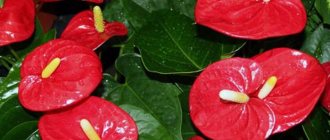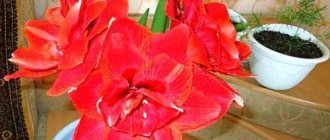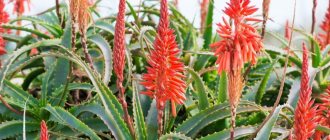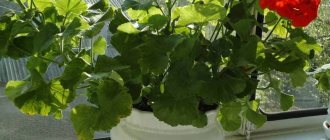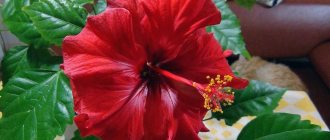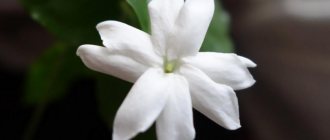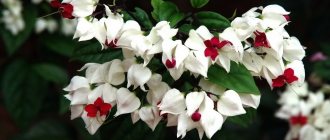Anthurium: pixabay.com If the “male happiness” flower first appeared in the house, then it is necessary to determine what living conditions the anthurium prefers. Caring for a plant does not require special knowledge, skills and abilities. It is enough to create optimal conditions for the existence of the flower. Read the article about how to care for anthurium after purchase.
Characteristics and description of the flower
Anthurium is a tropical plant that can be found in nature in South or Central America. Information about the flower first appeared at the beginning of the 19th century, but the plant did not gain popularity due to the fact that it required maximum attention and compliance with the rules of care.
Anthurium was grown only in special greenhouses, where temperature, humidity and lighting standards were observed. Later, with the advent of new, more adapted hybrid varieties, the popularity of the flower began to increase. Now it is impossible to imagine an amateur gardener who would not be familiar with anthurium.
The evergreen perennial plant belongs to the Araceae family. Refers to herbaceous or shrubby representatives of the flora. It has aerial roots, the tips of which are on the surface of the soil.
The height of anthurium ranges from 50 to 80 cm. In the collection of the family you can find about 800 species of anthurium, so the appearance of individual varieties may differ.
| Leaves | You can find plants with round or pointed leaf tips. In this case, their shape can be heart-shaped, arrow-shaped, lanceolate or spade-shaped. They can be either whole or dissected. The density also varies from thin to fleshy. The surface of the leaf can be smooth and in rare cases velvety. |
| Flowers | The flower is actually shaped like a spadix and has an inconspicuous hue. At the same time, the perianth leaf, which many people mistake for a flower, stands out as a bright spot against the background of the greenery of the plant. The leaf has a dense and smooth texture and comes in a variety of vibrant colors and shapes. |
Pests
The most common insects that like to settle on anthurium are:
- aphid;
- thrips with scale insects;
- spider mites;
- root nematode.
These insects, being parasites, suck juice from any parts of the flower, depriving them of nutrition. Signs of the appearance of insect pests can be determined during hygiene procedures regularly carried out during care.
What does anthurium look like in the interior?
A bright plant, some species of which can bloom all year round, will add rich colors to your interior. The variety of varieties, colors and shapes makes it easy to choose a plant for any room.
Please note that the aroma of the flower may also vary between varieties. You can find a plant with either a pleasant and light or a foul and pungent odor.
It is also believed that the presence of anthurium in an apartment has a positive effect on the general condition of its residents. The flower takes away all the negativity and gives out positive energy. For plant owners, things will always be in order, and all sorts of undertakings will be crowned with success.
How to propagate anthurium correctly
The flower is propagated by seeds and cuttings. When propagating by seed, collect planting material after artificial pollination. Since the seeds quickly lose their viability, they need to be sown immediately. Seed propagation procedure for beginners:
Types of anthurium
As already mentioned, the anthurium family has more than 800 species. The most popular have become several varieties that are distinguished by their lush and variegated flowering.
| Variety | Brief characteristics |
| Anthurium Andre | One of the most popular types. It is distinguished by a bright periflower blanket of red, less often white tones. It has a glossy surface with faint wrinkles. The appearance of the leaves is shaped like a heart, about 30 cm long and 12 cm wide. The leaf is attached to a long petiole. The inflorescence itself has the shape of a light-colored cob. Among the variety of indoor plants there is also the Anthurium Andre Champion variety, which is distinguished by more voluminous flowering. |
| Anthurium Scherzer | One of the most famous indoor species. It has a yellow or orange cob color surrounded by a red-orange spathe. The bright sheet has a not too dense structure with a varnished surface. The leaves are oval or lanceolate in shape with a sharp apex. Painted dark green. The surface below is matte, the surface above is glossy. They are located on petioles from 5 to 20 cm long. |
| Anthurium crystal | It is distinguished by the original color of the leaves, against a dark green background of which silver-white veins stand out. The leaves with a pointed apex are large, approximately 40 cm long. The small perianth leaf is almost invisible, as it is also colored green. The inflorescence has the shape of a yellow spadix. |
| Baker's Anthurium | A plant with narrow green oval-lanceolate leaves, reaching a length of about 50 cm. The flowers are very small and are located below the foliage level. The bedspread is painted yellow-green with purple edging. |
| Anthurium mix | A hybrid plant variety bred from the popular species Anthurium Andre and Anthurium Scherzer. It has a more compact size and abundant flowering. Such hybrids are more adapted to home growing conditions. |
Botanical description
In its natural environment, Anthurium is found in regions with a tropical climate. The perennial from the araceae family surprises with its diversity: biologists count more than 500 species. There are also those growing on trees, and those that have taken a fancy to rocks, and herbaceous plants.
All species have the same flower structure: a spadix and a large bract-veil. But the color of the spathe and the base of the inflorescence are different. White, yellow, all shades of red - this is just a small list. The leaves of the flower are petiolate, but there are different shapes, colors, and sizes: huge and small, plain and with pronounced veins, whole or carved. The duration of flowering depends on the variety and proper care: some species can delight with flowers for a whole year without interruption.
You need to be careful when contacting aroid plants: they are poisonous. The handsome anthurium is no exception. The juice of the flower contains oxalate, which can even cause swelling in the throat. Don't worry: swelling can only happen if you chew the leaves. Consider a place for your “pet” so that it cannot be reached by children and pets. To plant an anthurium flower or carry out other manipulations, it is recommended to use gloves.
Rules for growing at home
To keep your flower pleasing to the eye for a long time, regularly follow simple care rules.
Where can I place
Anthurium does not tolerate drafts, but requires an abundance of natural light. If your windows don't have cracks, place the plant on the windowsill. Otherwise, choose a place in a room with sufficient sunlight and no drafts. It is not recommended to leave anthurium near sources of artificial heat and electrical appliances, the influence of which negatively affects its health.
In winter, move the flower to the bathroom if there is a window there. High humidity and good lighting will help maintain the condition of the plant. In summer, you can place the anthurium in the living room or bedroom.
According to the teachings of Feng Shui, in order for a flower to absorb negativity and release positive energy, the pot must be installed in the eastern wing of the room.
Lighting
Anthurium loves plenty of natural light. However, it should be soft and diffused. Under no circumstances should leaves or flowers be exposed to direct sunlight. In summer you can place the pot in partial shade, and in winter you can place it near a window on the south side.
Which pot is suitable for the flower?
To create the optimal temperature for growing, choose a pot made of plastic. When choosing the size of the container, be guided by the following:
- the plant has aerial roots, which grow more to the sides rather than deep, so you will need a pot that is not deep and wide;
- if you want to propagate a flower, choose a wider container;
- for abundant flowering you will need a tight pot;
- in a vessel that is too large, diseases and harmful microorganisms can develop;
- A pot with a diameter of about 30 cm is suitable for an adult plant.
Priming
The soil should be as close to natural as possible, therefore it is necessary that the substrate has good air capacity, is well loosened and allows moisture to pass through. You can buy ready-made soil in the store or prepare it yourself. The main condition is a slightly acidic soil environment with a pH level from 5.0 to 6.0.
There are several options for preparing a suitable substrate. To obtain soil, simply mix these ingredients.
| Option 1. | Mix:
|
| Option 2. | Take all components in equal volume:
|
| Option 3. | Component ratio:
|
A suitable soil mixture should ideally consist of large granules that will not be compacted when watering, and will also be able to hold the plant well in the pot and ensure the necessary gas exchange.
Feeding and fertilizers
Anthurium does not have enough regular watering. In order for the plant to maintain lush foliage and not get sick, it needs to be fed.
You need to start fertilizing in early spring. Both mineral and organic fertilizers with a high nitrogen content are suitable for the procedure. With the arrival of summer, change your medications to phosphorus-containing ones. Since the roots of the plant are very vulnerable, when preparing the fertilizer, add 2 times more water than indicated in the instructions for the preparation.
Fertilize once every two weeks, pouring fertilizer under the roots and pouring water on top for better absorption of nutrients.
Temperature
Anthurium is thermophilic and can easily withstand high temperatures. In summer, the optimal temperature will be from 20 to 25 degrees, in winter - from 16 to 18 degrees. It is not recommended to install the plant near heating devices, as their influence will dry out the soil and the flower will lose the necessary moisture.
Air humidity
Anthurium loves high humidity, as well as warmth. The air humidity in the room should be approximately 80%. To achieve a suitable humidity level for growing a flower:
- install a humidifier near the plant;
- Place a container with wet pebbles or expanded clay under the pot;
- You can put a little moss on the ground so that its surface does not dry out;
- From time to time, spray the leaves with water from a spray bottle, bypassing the inflorescences;
- Do not overwater the soil, as this may rot the roots.
Your task is to create tropical conditions native to anthurium with high temperature and humidity.
Watering rules
For watering, use only settled or filtered water. Anthurium loves abundant but moderate watering. It’s easy to check the plant’s readiness for moisture - insert a wooden stick into the substrate; if lumps of earth do not stick to its surface, then watering is required. The optimal time for moistening is the moment when the soil has dried out to about 1/3 in depth.
In spring and summer, the regularity of watering should be no more than once every 3 days, and in autumn and winter it should be reduced to 1-2 times a week.
Trimming
Perform pruning immediately after the plant has flowered. Cut the wilted bud at the base with a sharp knife, and sprinkle the cut with activated carbon powder. If the perianth cover is already quite dry, carefully tear it off. The core will dry out over time and be easily removed.
ANTHURIUM. CARE.
Houseplant ardisia care at home, growing features and recommendations
With good care, anthuriums bloom from spring to autumn. Good care primarily means correct thermal conditions. The anthurium plant is thermophilic. In summer, moderately warm temperatures are best, but in winter the temperature should not fall below +18 degrees. The plant should also be protected from drafts, but ensure access to fresh air.
Anthuriums love bright light, but not direct sunlight, from which they need to be shaded. In winter, you also need bright light. In rooms, east or west windows, or stands near them, are best suited for anthurium.
For anthurium plants, care also means proper watering. The water should be soft and well-settled, preferably boiled, always warm. Water regularly, but little by little, avoiding stagnation of water in the pan. Anthurium leaves should be regularly washed to remove dust and it is advisable to spray them frequently.
During the growth period, anthuriums are fed once every two weeks with mineral and organic fertilizers.
Like most plants, the anthurium flower rests in winter. During this period, as the temperature drops, watering and fertilizing are significantly reduced, but the soil in the pot should not be allowed to dry out.
Anthuriums are transplanted in the spring into wide and low pots with well-arranged drainage. The pot should be small, otherwise the anthurium will bloom poorly
Leaves and fragile roots, which break easily, should be handled with care. When replanting, anthuriums should be planted slightly lower than they were before replanting, and as they grow, the roots that appear above the ground should be covered with moss, which should be moistened regularly, otherwise the anthurium will dry out.
The best soil for anthuriums is a mixture of fibrous coarse deciduous soil, pieces of bog moss and light turf soil. The soil does not need to be compacted too much, which ensures air access to the roots. Anthurium does not tolerate alkali, either in the ground or in watering. The soil must be acidic, and the water for irrigation must be soft.
Transfer
Throughout its life, the plant requires regular replanting. Your actions must be careful and careful not to injure the delicate roots of the anthurium.
When to replant anthurium
First of all, replant the anthurium immediately after purchase, since store-bought substrate may contain excessive amounts of minerals and carcinogens.
Subsequent transplants will be required as the root system grows. For young plants, the frequency of transplants is 1 time per year. It is advisable to replant flowers that have reached four years of age at least once every 3 years.
Also, replanting or replacing the soil will be required if the anthurium gets sick.
Choosing a pot
Choose a pot depending on the base of the transplant. For example:
- if the root system has occupied the entire substrate, choose a container 2–3 cm larger than the previous one;
- if new shoots are needed, choose a wider vessel;
- for abundant flowering when replanting, take a form that is larger in size than the old one by a maximum of 2 cm;
- For planting young shoots, use small 200 ml cups.
There must be holes at the bottom of the pot for drainage.
Before use, be sure to disinfect the container with soapy water or pour boiling water over it.
Land for replanting
For replanting, use a soil type suitable for anthurium. You can buy a ready-made mixture or prepare the substrate yourself.
Anthurium transplant after purchase
Perform the procedure approximately 4–5 days after purchase. This time will be enough to acclimatize the plant.
Action plan:
- Water the soil thoroughly.
- If the pot is plastic, knead it a little so that the substrate moves away from the walls.
- Carefully remove the root ball from the container.
- If possible, remove any old soil from the root hairs.
- Carefully inspect the roots for damage and rotting.
- Fill the new form with a drainage layer, such as expanded clay.
- Fill the drainage with new soil.
- Place the plant in the pot and cover it with soil, leaving 2-3 cm to the edge of the container.
- Lightly compact the substrate.
When replanting to replace soil, the roots are completely cleared of soil. To make the soil move away from the hairs more easily, briefly soak the root ball in water.
Is it possible to replant a flowering plant?
Despite the fact that most plants do not survive transplantation during flowering, anthurium survives the procedure quite well. During replanting, pay utmost attention to both the integrity of the root hairs and the flowers.
Transplanting a diseased anthurium
If the leaves of the anthurium turn yellow, become deformed or wither, then the functioning of the root system has been disrupted. To revive the plant, you will have to replant the flower and replace the soil.
The procedure is no different from a regular transplant. However, during the procedure, pay special attention to clearing the rhizome from soil and processing the hairs. Carefully examine the roots and remove diseased and rotten parts. Treat the remaining hairs with Actellik. Also separate yellow and wilted leaves from the bush.
What to do after transplant
To ensure that anthurium takes root in a new substrate, follow the following recommendations:
- in the first 15–20 days, water less often than usual so that the roots do not rot from excess moisture;
- during the same period, do not add any fertilizers to the soil;
- provide the plant with optimal temperature conditions ranging from 20 to 22 degrees;
- do not place the flower in places exposed to direct sunlight;
- Spray the surface of the sheets with settled water daily.
If the plant is large, strengthen the stems by tying them to a support.
Flower growers' headaches: care problems and how to solve them
Growing “male happiness” at home is not easy because of its capricious nature. Instead of admiring the beauty of the plant, you often have to think about how to save the “pet”. Why do anthurium leaves turn black and the plant begin to turn yellow and dry out? Most flamingo flower diseases are caused by improper care. You can save the plant if you work on the mistakes. And here it is important to determine the cause of the problem, which the following table will help with.
Table - Problems when growing anthurium and their causes
| Problem | Causes |
| The leaves are turning yellow | — Long-term waterlogging of the earthen coma; - chlorinated water; — too concentrated recharge; — insufficient lighting; - tight container |
| Leaves turn black | — Drafts; - too dry air; — violation of the temperature regime (too hot or cold); - direct rays of the sun; - substrate with excess potassium |
| Brown spots | — Overmoistening; - unsuitable soil; — damage to the root system; — hypothermia of roots; - hard or too cold water |
| The tips of the leaves dry out | — Anthracnose (weakened plants and flowers with mechanical damage get sick) |
| The plant dries up | — Insufficient watering; - dry air |
| The leaves are curling | — Drafts; - dry air; - lack of light |
| Wilting foliage | — Root rotting from overwatering |
In order for the “flamingo flower” to delight you with its beauty for a long time, you need to learn all the subtleties of care. If comfortable conditions are created for the tropical guest, the leaves will have to be trimmed only because of “old age”, and not because they have lost their attractiveness.
By optimizing care, many problems can be solved. But if rotting of the roots occurs, then you need to immediately replant the plant. The longer you delay replanting, the less chance you have of saving the flower. When replanting, you need to cut off the affected root parts, leaving the remaining parts in the air for half an hour to dry. If you plan to simply replace the soil, leaving the same container, be sure to disinfect it with a strong manganese solution.
Anthurium propagation methods
To propagate the plant, wait until the anthurium reaches maturity. There are several methods of reproduction, each of which has certain subtleties and nuances.
Daughter plants
The method is quite simple and guarantees almost 100% results. It is better to carry out the procedure at the time of transplanting the anthurium.
Pre-prepare small containers with soil for planting sprouts. Immediately after removing the adult plant from the pot, carefully separate the young shoots along with the roots and plant them in molds. Young anthuriums should be cared for in the same way as adults. If the root system of the shoots is not sufficiently developed, it can be grown in a mixture of overwater and sand.
Apical cuttings
Reproduction in this way is possible only during the period when the plant is not blooming. Procedure:
- Prepare the substrate by mixing peat and sand in equal proportions.
- Cut the apical stalk 5 to 8 cm long.
- Ventilate the cutting for no more than 5 minutes, and then root it in the substrate.
- Cover containers with sprouts with polyethylene, creating a greenhouse effect.
- Moisten the sand-peat mixture daily and ventilate the sprouts.
Some gardeners dip the cuttings into settled water, where they are also able to take root.
Seed propagation
The peculiarity of planting anthurium seeds is the quality of the material. Only fresh seeds can sprout. If you have the opportunity to buy fresh seeds or collect seeds from your plant, you can safely use this propagation method.
If you want to collect seeds from your plant, be prepared for the process to take a very long time.
First of all, in order for fruits with seeds to appear, the flowering plant must be pollinated. Transfer pollen from the stamens to the pistils of the flower with a soft brush and repeat the procedure after a few days to ensure uniform maturation of the buds.
If you do everything correctly, in 6–8 months you will see fruits on the plant. The seeds are considered ripe after the fruits have changed color. Remove them from the fruit and dry them for several days.
After drying, the seeds can be planted. For this:
- Prepare a small, wide container and loose soil, such as peat.
- Carefully transfer the seeds into the soil and sprinkle with a thin layer (no more than 3 mm) of substrate.
- Moisten the surface of the soil with seeds using a spray bottle.
- Place the containers in a bright place, away from direct sunlight, covering them with polyethylene. The air temperature should be kept between 20 and 24 degrees.
- Spray the soil and ventilate the crops daily.
You will notice the first buds after 7–14 days, and a leaf after about 4–5 weeks. When 3 leaves appear on the shoot, the seedlings should be planted in separate forms.
How does anthurium reproduce?
Reproduction of the epiphyte is possible in several ways: by dividing the bush, seeds, cuttings, and air layering.
Germination of seeds
Seed propagation pays off when you need to grow a large number of young seedlings. The process is labor intensive and takes a lot of time. Daughter plants often do not retain the properties of the mother hybrid; it is not known what color of inflorescences the seedling will grow with.
To obtain seeds, artificial pollination is used, which is carried out within 5-8 days to ensure results. At the site of the inflorescence, from 2 to 20 berries are formed, which ripen for 8-12 months. Ripe fruits are kneaded, small seeds are removed, and disinfected in a solution of potassium permanganate.
Important! Anthurium seeds germinate in the light, so when sowing they are laid out on the surface of the soil.
The optimal temperature for seedlings is +22-25 °C. The first shoots appear after two weeks. Seedlings dive in the phase of the first true leaf. Seedlings are planted in separate pots when they reach a height of 5-7 cm. Young plants bloom after 1.5-2 years.
Rooting cuttings
Cuttings are the most common type of flower propagation. Cutting is a leaf cut with a part of the stem 5-8 cm long. Planting material is taken from the mother plant, and the cut sites are disinfected. The cuttings are dried for 10-15 minutes. Place for rooting in small pots with sphagnum moss or a mixture of peat chips and sand.
You can root cuttings in water, which needs to be changed daily. To ensure that the cuttings give roots more quickly, a solution of root or heteroauxin is added to the water. The cuttings are covered with a plastic bag to maintain the required humidity and temperature, not lower than +25-28 °C. Ventilation is provided every day.
Root buds appear within a week. After a month, the seedlings can be planted in small pots with a diameter of 10 cm in soil suitable for an adult plant.
Propagation by Anthurium cuttings
Air layering
Anthurium can be propagated by rooting side shoots (air layering). Children are separated during transplantation. Prepare small pots filled with a mixture of sphagnum moss, humus and perlite. Layers with small roots are treated with a biostimulant and planted to a depth of 2-3 cm. Using plastic film, a mini-greenhouse is set up, maintaining a temperature of +28-32 ° C and a humidity of 85%. Arrange for daily ventilation.
Other options
The propagation method by dividing the bush is suitable for plants older than 3-4 years. This procedure allows you to simultaneously rejuvenate the flower.
Procedure:
- water the bush the day before;
- remove the flower from the pot, shake off the substrate from the roots;
- carefully straighten the roots, trying not to damage their fragile structure;
- trim off dark dead areas, sprinkle the cut areas with crushed coal;
- divide the epiphyte into 2-3 bushes;
- choose pots that are small in diameter;
- plant the plants, deepening the roots sufficiently;
- water generously.
Note! After transplantation, the divisions bloom the next year.
Diseases and possible pests
Anthurium is rarely affected by disease. All problems with his health often appear due to improper care. It is enough to restore the temperature and light conditions, adjust the humidity and watering for the plant to be revived.
Pests that settle on a flower can cause a lot of trouble.
| Pest | Signs of appearance | Treatment |
| Aphid | The leaves dry out and the plant grows slowly. They settle mainly on the underside of the leaf blade. | Treat the stems and leaves of anthurium with a special insecticide against the parasite. |
| Shields | Beige or brown tubercles appear on the leaves. Easily separated from the surface with a wooden stick. | Water the plant with a solution of a systemic insecticide, for example, Aktara. The substance will be absorbed into the sap of the plant and enter the body of the parasite, thereby neutralizing it. |
| Spider mite | On the surface of the plant you may notice cobwebs or punctures in the leaf blade. | First of all, wash the leaves of the flower with a soapy solution, and then treat with an acaricide. |
| Thrips (small midges) | Microorganisms that can cause a fungus or virus are left on the surface of the leaf plate. As a result, the leaves become pale yellow or white. | Treat the bush with special products. Additionally, sticky traps can be installed. |
| Whiteflies | Butterflies are very easy to spot. They affect the leaf plate, as a result of which the leaves become deformed and lose color. | Treat the plant with special insecticides. |
Diseases
Failure of a plant to produce flower stalks often results in disease.
- Sometimes dark spots appear on the surface of the leaves. The reason for their appearance is that the temperature in the room is too low. Essentially the plant freezes.
- Infections often affect all parts of the “flower of love.” Anthurium can be infected by viruses and microorganisms. There is no countermeasure against them yet, and therefore such diseases lead to the death of the bush.
- Some infections can be treated with chemicals sold in stores. For example, in some cases you can get rid of the infection with potassium permanganate or Glyokladin.
- Fungal diseases are treated with fungicides. But this is only possible with timely treatment.
Solving problems and difficulties during cultivation
While growing anthurium, you may encounter some problems and difficulties, the timely solution of which will help cure and restore the plant.
Why do the leaves dry out and turn yellow?
Yellowness and dryness of the leaves indicate that the plant is either in a draft or simply frozen. By restoring the temperature regime and moving the pot to another place, you will bring the flower back to life.
Why do anthurium leaves crack?
If the leaves are cracked, then the soil or the quality of the water used for irrigation is not suitable for the plant. The flower should not be watered with fresh running water. Before watering, the liquid must stand in the room for at least a day.
Why doesn't anthurium bloom?
Lack of flowering can be caused by insufficient lighting, disturbed temperature conditions and lack of fertilizing. Simply fertilize the soil and move the pot to a suitable room with more light. Also, anthurium may not bloom if its root system is significantly smaller in volume than the substrate. In such a case, simply transplant the plant into a smaller pot.
What to do if there are brown spots on the leaves
There may be several reasons for this phenomenon:
- excessive watering;
- incorrectly selected soil;
- the plant is too hot and dry (the tips of the leaves darken);
- anthracnose fungus (there is a small black dot in the center of the spot).
Once proper care is restored, the stains will go away. If the flower is infected with fungus, spray the leaves with an antifungal agent, following the instructions on the package.
If the leaves have darkened completely, it means that you are watering the anthurium with too cold and unsettled water.
How to update an old anthurium
As the anthurium grows, old leaves die off and new ones form on top. Due to this phenomenon, the flower loses its presentable appearance. To restore the plant's attractiveness, cut off and root the top. The procedure is convenient to do during transplantation.
Why do Anthurium flowers turn green?
For some varieties this is a natural process that occurs at the end of flowering. If you carefully remove the green flowers, it will be easier for the plant and it will bloom again faster. If the process is regular, the rules of care may have been violated, and if restored, the problem will go away.
If the roots have rotted, how to save the anthurium
If the roots are completely rotten, try to restore the plant by rooting cuttings. Perform all actions in the same way as during reproduction.
Why does anthurium grow poorly?
If the anthurium begins to grow slowly, think about whether you have changed its location, due to which the quality of lighting or watering has changed. Mineral fertilizers and fertilizing, as well as the resumption of proper watering and lighting levels, will help restore the flower.
Why does anthurium have small leaves and flowers?
With a similar phenomenon, anthurium indicates a lack of nutrients, moisture or lighting. Feed the plant, restore watering and lighting, and the flower will grow.
Why does anthurium wither?
It happens that the flower begins to emit an unpleasant odor. The problem can be caused by either hypothermia of the plant or fsarium disease, which appears from an excess of liquid, as well as infection from pets or dirty hands.
How often does anthurium bloom?
Anthurium blooms for more than six months, resting only in the harsh winter. The first flowers bloom as early as March and can remain on the stems for several months. When cut, anthurium flowers can last in water for about a month.
Growing an anthurium is not difficult if you follow all the subtleties of care: install the flower in a suitable place, regularly feed and replant, and observe watering standards. The plant reacts instantly to any violation of the regime. Before purchasing an anthurium, consider whether you can provide the flower with proper care.
Short description
The leaves of this representative of the flora are bright green, heart-shaped. They grow up to 40 cm in length. Flowers appear above these luxurious green parts of the plant. They can be purple and pink, scarlet and white. The originality of the flowers lies in the presence of a flower spadix and a bract.
But the exotic representative of the flora is capricious and demanding. They say that if you put this plant on the ground, it will find out how to take root, being on the ground or a tree, and still bloom. Subtropical and tropical climates encourage anthurium to bloom. That’s why its inflorescences are bright, the plant itself is huge and luxurious, but what can you do at home to decorate the room and be proud of your own floriculture skills?
The window sill of a house or office will not provide the necessary conditions corresponding to the subtropics. This means you have to make an effort. Your pet will definitely thank you with flowers.
Indoor flowers anthurium plant features
Anthurium belongs to the aroid family. There are two groups of these evergreen indoor plants: flowering and decorative deciduous. They have the following features:
- flowers can be stored for a long time after cutting;
- the leaves of the plant humidify the air;
- the houseplant anthurium is poisonous (if ingested it causes vomiting, diarrhea, dermatitis);
- an ornamental plant is capable of absorbing toxic substances;
- propagated by dividing the bush, seeds and cuttings of stems and leaves;
- little susceptible to pests;
- rarely get sick.
Possible problems
The causes of the most common problems are as follows:
- Rotting of the stem and rhizome - waterlogging of the soil and stagnation of water.
- Blackening of the tips of the leaves is an overabundance of calcium salts in the soil.
- Leaves curl - dry air, drafts, direct sunlight or lack of light.
- The brownish tip of the leaf and the pale center are too bright lighting.
- Anthurium leaves turn yellow and their ends turn brown - oversaturation with nutrients, damage to the roots.
- Few flowers and a lot of foliage - insufficient or excessive lighting.
Anthurium: care at home
Humidity and light are of primary importance. If these indicators are maintained at normal levels, there will be no hassle with the ornamental plant.
Location
Anthuriums prefer diffused light or partial shade. They do not like direct sunlight or complete darkness. It is better to place them on windows on the northwest or east side.
Temperature
Anthuriums love consistently high temperatures. They grow and bloom all year round at +20°C - +27°C. If in winter you want the plant to rest (not bloom or grow), the air temperature in the room should be reduced to +16°C.
Watering
For irrigation, you need soft, well-settled water at room temperature (preferably boiled). The top soil layer should not be allowed to dry out between waterings. At the same time, waterlogging of the substrate is also unacceptable. Therefore, you need to drain the water from the pan in time.
In order for the plant to bloom profusely in the spring-summer period, it is given rest in the autumn-winter season. To do this, reduce watering starting in September and lower the ambient temperature. You can move the flower to a cooler room.
Air humidity
Anthurium is a tropical plant. Therefore, it prefers fairly high humidity. To ensure optimal conditions for anthurium, you can create the following conditions for it:
- cover the stems with sphagnum moss or other hygroscopic material;
- regularly spray the stems, leaves and moss (during the flowering period, try not to get on the flowers, which may become covered with brown spots from the water);
- place the flower in a tray filled with wet gravel or expanded clay;
- Periodically wash off dust from the leaves with a damp sponge.
Top dressing
Fertilize with low concentrated solutions every three weeks during the warm months of the year. Avoid excess mineral salts and lime. Anthuriums are very fond of weekly foliar feeding of foliage. Optimal fertilizers:
- azofoska in combination with potassium humate (1 g + 200 mg per liter of water);
- horse dung;
- leaf humus;
- chicken droppings;
- mullein infusion.
Soil composition
The soil substrate for an ornamental plant is made from
- unsifted leafy soil - one part;
- sand - half of the part;
- humus - two parts;
- peat - one part.
It is useful to add pieces of charcoal, dry mullein, brick crumbs, and foam balls (15% of the total amount of substrate) to the soil.
Pests
When the first symptoms appear, the plant is treated with a soap solution, washed with warm water and sprayed with Actellik (2 ml per liter of water).
Onion tincture, tobacco solution and garlic also help to cope with pests.
Types and varieties of anthurium
Among the enormous wealth of representatives of the genus, only a few species are considered the most adapted to growing indoors.
As a result of selection, they presented gardeners with hundreds of varieties and hybrids with often unusual shapes and colors of bedspreads, which can be in different shades of white, pink, green, red, bronze with or without specks, as well as colors that are completely exceptional for these plants - yellow and purple.
Anthurium Andreanum and its hybrids are currently the most popular houseplant with red, purple, pink, yellow or white leathery petals with well-defined veins.
Anthurium andreanum
Almost all the flowers you see in a flower shop will be varieties of this species. The plant can reach 100 cm in length.
The flowers are large - the length of the spathe is 20 cm and the width is 18 cm. The heart-shaped leaves, depending on the variety, can be green or variegated. Blooms in spring and summer.
Varieties of this type:
“Acropolis” and “Fantasy” - a variety with a white blanket against a background of green glossy leaves, “Carré” in a pink hue, spectacular “Crimson Love”, “Fantasy Love” with unusual light green-pink petals, delicate lilac-violet “Fiorino”.
Anthurium Andreanum variety Fantasy Love
Anthurium scherzerianum Schott. A rather unpretentious species, the height of the peduncles is 20-50 cm. The leaves are dark green, oblong, elliptical or lanceolate, the length can exceed 20 cm.
Orange or orange-red inflorescence - the spadix is slightly twisted in a spiral, which is characteristic of this species. The cover is bright, in all shades of red, in some varieties it is creamy with red spots.
Anthurium scherzerianum
Varieties: “Sunny”, “Arabella”, white with a variegated red scattering of “Stephanie”, “Tessa”, “Artus”, “Amaretti” with a light orange cover and a scattering of spots.
Anthurium crystallinum. It is characterized by very decorative heart-shaped green leaves with a velvety coating, on which light veins are clearly visible.
Anthurium crystallinum
The greenish fragrant inflorescences-cobs with a small green cover are inconspicuous, so the species is grown solely for its spectacular foliage, which has an unusual crystal shine.
Majestic (Anthurium magnificum Lind). This decorative deciduous species is similar to the Crystal Anthurium, but differs in its rapid growth and the shape of the tetrahedral petiole.
Anthurium magnificum
Its large, gorgeous dark green leaves have a velvety texture and can be bicolored with silver lines along the main veins. These lines give the foliage a dramatic shine. The bedspread is green, re-curved. The cob is yellow-green.
Anthurium hookeri, also called "bird's nest" is a rather rare variety in cultivation with large leaves with light veins, the length of which in the natural environment can reach 80 cm. The flowers are pale lilac, but does not bloom often.
Veitch's Anthurium (Anthurium veitchii). Huge, corrugated leaves are the main decorative element of the native Colombian. This is a rare plant for true collectors and experienced gardeners.
ANTHURIUM. VARIETIES
There are many known types of anthurium, but not many are suitable for growing indoors, so we will only talk about them.
Firstly, this is the Scherzer's anthurium (A. scherzerianum) - the most suitable anthurium flower for indoor floriculture. The plant reaches 30 cm in height. The leaves of Scherzer's anthurium are oblong, leathery, dark green in color. The leaf length is about 20 cm. The flowers consist of a bright bent spathe - a bract about 5 cm long and a spadix twisted into a spiral.
Secondly, Andre's anthurium (A. andreanum), which is much larger than Scherzer's anthurium, can
grow up to one meter tall. The leaf is large (20 cm long), similar to a heart. The flower is also larger, the bract is up to 10 cm long, and the spadix is straight or slightly curved. Anthurium Andre is less suitable for indoor growing and is much less common than Anthurium Scherzer.
All anthurium leaves are beautiful, but there is an anthurium with especially beautiful leaves - this is crystal anthurium (A. crystallinum), which is grown as an ornamental foliage plant. Anthurium crystal leaves are small, velvety and change color with age. The leaves of a young plant are reddish, while those of an adult are dark green. Each leaf has symmetrical silver veins, which are clearly visible on the leaves, which determines the decorative nature of this plant.
